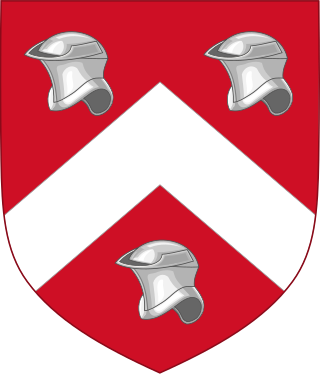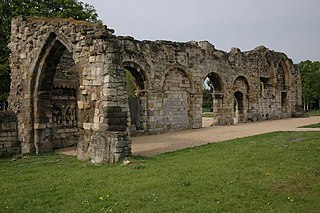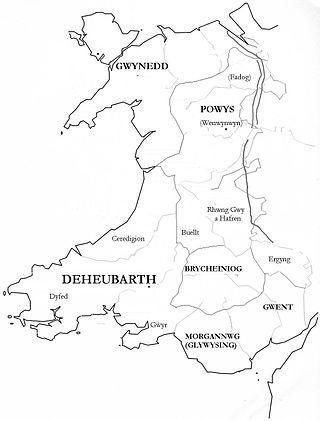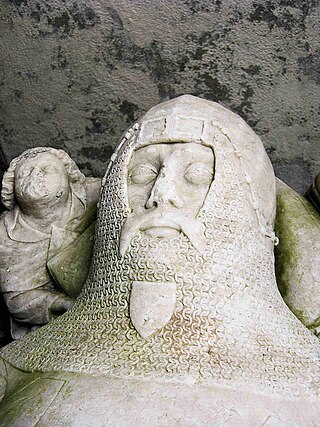
Æthelstan or Athelstan was King of the Anglo-Saxons from 924 to 927 and King of the English from 927 to his death in 939. He was the son of King Edward the Elder and his first wife, Ecgwynn. Modern historians regard him as the first King of England and one of the "greatest Anglo-Saxon kings". He never married and had no children; he was succeeded by his half-brother, Edmund I.

Gruffydd ap Llywelyn was King of Gwynedd and Powys from 1039 and, after asserting his control over the entire country, claimed the title King of Wales from 1055 until his death in 1063. He was the son of Llywelyn ap Seisyll king of Gwynedd and Angharad daughter of Maredudd ab Owain, king of Deheubarth, and the great-great-grandson of Hywel Dda. Gruffydd was the first and only Welsh king to unite all of Wales albeit for a brief period. After his death, Wales was again divided into separate kingdoms.

Sir Owen Tudor was a Welsh courtier and the second husband of Queen Catherine of Valois (1401–1437), widow of King Henry V of England. He was the grandfather of Henry VII, founder of the Tudor dynasty.

Gruffudd ap Cynan was King of Gwynedd from 1081 until his death in 1137. In the course of a long and eventful life, he became a key figure in Welsh resistance to Norman rule.

Æthelred, Lord of the Mercians became ruler of English Mercia shortly after the death or disappearance of its last king, Ceolwulf II in 879. Æthelred's rule was confined to the western half, as eastern Mercia was then part of the Viking-ruled Danelaw. His ancestry is unknown. He was probably the leader of an unsuccessful Mercian invasion of Wales in 881, and soon afterwards he acknowledged the lordship of King Alfred the Great of Wessex. This alliance was cemented by the marriage of Æthelred to Alfred's daughter Æthelflæd.

The historicity of King Arthur has been debated both by academics and popular writers. While there have been many claims that King Arthur was a real historical person, many specialists on the period consider him to be a mythological or folkloric figure.
Gwenllian ferch Gruffydd was a 12th century Welsh rebel and Princess consort of Deheubarth. The daughter of Prince of Gwynedd Gruffudd ap Cynan and member of the House of Aberffraw, she married Gruffydd ap Rhys, the Prince of Deheubarth, and would lead a "patriotic revolt" with him during the Great Revolt of 1136 until her death at the battle at Kidwelly Castle.

Bleddyn ap Cynfyn, sometimes spelled Blethyn, was an 11th century Welsh king. King Harold Godwinson and Tostig Godwinson installed Bleddyn and his brother, Rhiwallon, as the co-rulers of kingdom of Gwynedd on his father's death in 1063, during their destruction of the kingdom of their half-brother, king Gruffydd ap Llywelyn. Bleddyn became king of Powys and co-ruler of the Kingdom of Gwynedd with his brother Rhiwallon from 1063 to 1075. His descendants continued to rule Powys as the House of Mathrafal.
Ednyfed Fychan, full name Ednyfed Fychan ap Cynwrig, was a Welsh warrior who became Seneschal to the Kingdom of Gwynedd in Northern Wales, serving Llywelyn the Great and his son Dafydd ap Llywelyn. Ednyfed claimed descent from Marchudd ap Cynan, Lord of Rhos, 'protector' of Rhodri Mawr, King of Gwynedd. He was the patrilineal ancestor of Owen Tudor and thereby of the Tudor dynasty.
Caradog ap Gruffydd was a Prince of Gwent in south-east Wales in the time of Gruffydd ap Llywelyn and the Norman conquest, who reunified his family's inheritance of Morgannwg and made repeated attempts to reunite southern Wales by claiming the inheritance of the Kingdom of Deheubarth.

Brycheiniog was an independent kingdom in South Wales in the Early Middle Ages. It allied with the Mercian kingdom in the post Roman era, to stabilise and control a central (Marches) area key to dominance over central Proto-England to the east and the south Welsh kingdom of Deheubarth to the west. It was conquered and pacified by the Armorican Normans between 1088 and 1095, though it remained Welsh in character. It was transformed into the Lordship of Brecknock and later formed the southern and larger part of the historic county of Brecknockshire. To its south was the Kingdom of Morgannwg.
Athrwys ap Meurig was a prince, and possibly king, of Gwent and Glywysing in Wales. He was the son of King Meurig ap Tewdrig and the father of the later king Morgan ab Athrwys. It is possible he died before his father Meurig and did not live to rule as king himself.

Gwent was a medieval Welsh kingdom, lying between the Rivers Wye and Usk. It existed from the end of Roman rule in Britain in about the 5th century until the Norman invasion of Wales in the 11th century. Along with its neighbour Glywyssing, it seems to have had a great deal of cultural continuity with the earlier Silures, keeping their own courts and diocese separate from the rest of Wales until their conquest by Gruffydd ap Llywelyn. Although it recovered its independence after his death in 1063, Gwent was the first of the Welsh kingdoms to be overrun following the Norman conquest.

Glywysing was, from the sub-Roman period to the Early Middle Ages, a petty kingdom in south-east Wales. Its people were descended from the Iron Age tribe of the Silures, and frequently in union with Gwent, merging to form Morgannwg.
Morgannwg was a medieval Welsh kingdom formed via the merger of the kingdoms of Glywysing and Gwent.

Tudur ap Goronwy was a Welsh landowner, soldier and administrator of the Tudors of Penmynydd family from the island of Anglesey.
Ffernfael ap Meurig or Ffyrnfael or Fernmail, fl. 880s, was king of Gwent in southeast Wales jointly with his brother Brochfael. Asser says in his biography of Alfred the Great that "Brochfael and Ffyrnfael,, driven by the might and tyrannical behaviour of Ealdorman Æthelred and the Mercians, petitioned King Alfred of their own accord, in order to obtain lordship and protection from him in the face of their enemies".
Owain ap Hywel was a king of Glywysing and Gwent in southeastern Wales.

Cyfeilliog or Cyfeiliog ; probably died 927) was a bishop in south-east Wales, but the location and extent of his diocese is uncertain. He is recorded in charters dating from the mid-880s to the early tenth century, and in 914 he was captured by the Vikings and ransomed by Edward the Elder, King of the Anglo-Saxons, for 40 pounds of silver. Edward's assistance is regarded by historians as evidence that he was overlord of the south-east Welsh kingdoms. Cyfeilliog is probably the author of a cryptogram in the ninth-century collection of poetry known as the Juvencus Manuscript. The cryptogram would have required knowledge of Latin and Greek. The twelfth-century Book of Llandaff records his death in 927, but some historians are sceptical as they think that this date is late for a bishop active in the 880s.